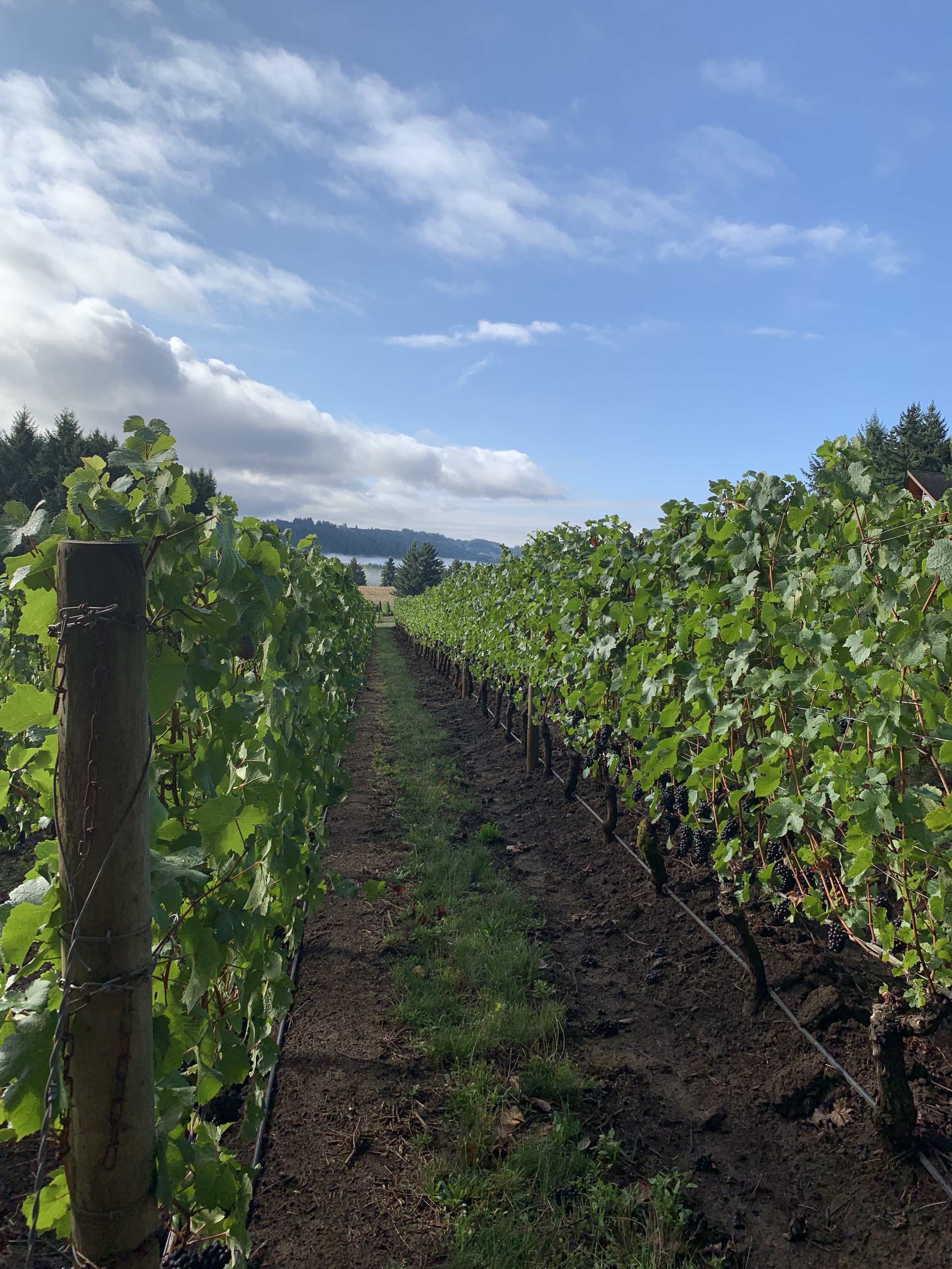“Of life’s two chief prizes, beauty and truth, I found the first in a loving heart and the second in a laborer’s hand.”

It begins in the vineyard
Author Wendell Berry wrote, "Eating is an agricultural act." We believe the same is true of drinking wine. Amid pages of glossy magazines, white tablecloths, and beautiful wineries, it is easy to forget that the magic in the glass wasn't conjured up from thin air. It was grown. Meticulously. By the hands of honest, hard-working people. Drinking wine is the most refined of agricultural acts.
PROJECT M believes in the power of farming so thoroughly that we value the quality of farming over the vineyard's potential. A great farmer can squeeze every drop of potential from every opportunity by making the right decisions at the right time.
Our greatest fortune is that we don't have to choose between quality farmers and vineyards. Our access to great Willamette Valley sites, nurtured by expert farmers, allows us to do meaningful work.
That work begins with each vine. The vine is comprised of two halves: that which lives above the ground and that which lies beneath. The meticulous grooming of the canopy, leaves, and shoots keeps the vine free of disease. The details and timing of grooming modulate grape chemistry, giving us more of what we want and less of what we don't, according to our desired stylistic outcomes. Such is the art of winegrowing.
Caring for the environment around the roots, nurturing both the vine and the community of life it depends upon, contributes to a wine's sense of self and, by extension, place.
Our farmers care for both halves of the vine as we believe this is the only way our wines can be whole. All of our fruit is sustainably grown, some go a step further and are grown organically or biodynamically. All of it is grown with respect for the land. With that respect and reverence, we can translate an agricultural act into something of beauty.
-
Tualatin Hills AVA
Located west of Gaston, Bednarik Vineyard is nestled in the eastern foothills of the Coast Range. The vineyard's soils are largely marine sediments, intermingling with Missoula Flood sediments on its lower portions. Winds from the Coast Range cool the south-southwest facing slope.
Planted in the early 1980's the vineyard's Pommard and Wadenswil clone Pinot Noir provide an increasingly rare opportunity to work with "own" rooted vines.
Managed by: Vineyard Brothers
GPS: 45.451676-123.230009
-
Chehalem Mountain AVA
Chehalem Mountain Vineyard was Initially planted in 1968 by Dick Erath, one of Jerry's mentors, it is now owned by Cooper Mountain Vineyards. Located in the Chehalem Mountain AVA, the soils originate from ancient sea beds and belong to the famed "Willakenzie" series. PROJECT M's block sits on a gently west-facing slope with Pommard clone Pinot Noir grafted onto 3309 rootstock.
GPS:45.362082-123.059766
-
Eola-Amity Hills AVA
The Eola-Amity Hills have long been the source of some of Oregon's finest Pinot Noirs. Filament Vineyard is located on the east side of the Walnut Hill section of the AVA. Though indirect, its high elevation and exposure to the Van Duzer winds slow ripening and maintain acidity.
The Gelderman soils are volcanic in origin, arising from weathered basalt from the ancient Columbia River basalt flows. Though deep, vine vigor is kept in check by the shallow rooting habit of the Riparia Galore rootstock. Planted in 2001, Filament's 2.4 acres are a collection of Dijon and Pommard clones harvested in a single pass as a field bend.
Managed by: Stirling Wine Grapes (aka SWIG).
GPS: 45.126849-123.149067
-
Eola-Amity Hills AVA
Located on the West side of the Eola-Amity Hills, most of Five Point Vineyard features volcanic red clay soils. However, the Chardonnay block planted to clones 95 and 76 shows a transition into marine sediments. At just over 400', the block has a modest slope that accumulates cool nighttime air from the hills above, resulting in excellent acidity.
Farmed by Results Partners
45°06'11.9"N 123°09'50.2"W
-
Chehalem Mountain AVA
At over 600' on Rex Hill the La Cantera Vineyard faces slightly Southwest across the French Praire. The soils are wind-blow loams of the Laurelwood series and yield opulent, dark-fruited wines. The clones we source from the sight are Pommard, 667 and 777.
Farmed by Lundeen Wines.
45°19'11.5"N 122°54'55.5"W
-
McMinnville AVA
Located in the McMinnville AVA, the Momtazi Vineyard is just one chapter in the incredible life story of its founder, Moe Momtazi. It is faithfully farmed biodynamically and Demeter-certified. A large and diverse vineyard, PROJECT M sources from Block C, a large south-facing promontory with thin volcanic soils planted to Dijon Clone 115 Pinot Noir grafted onto Rootstock 3309. Though hot and dry by day, the evening winds from the Van Duzer Corridor cool the vineyard.
Farmed by: Moe Momtazi
GPS: 45.156750-123.306585
-
Dundee Hills AVA
Owned by Lemelson Vineyards, Meyer Vineyard is a stark contrast to the Wascher Vineyard. Located high in the Worden Hill Road section of the Dundee Hills, the Riesling resides on a steep west-facing slope that tops out at 800 feet. The red clay volcanic soils are textbook examples of the Jory series. Its high elevation and cool clay soils delay bloom up to 10 days later than the Wascher Vineyard, with which it is picked and co-fermented. Though young, planted in 2007, its laser-like citrus qualities are promising. Like Wascher, it is also certified organic.
Farmed by: Lemelson Vineyards
GPS Meyer: 45.281710-123.043591
-
Eola-Amity Hills AVA
Pearlstad Vineyard is a Chardonnay-focused site on the West side of the Eola Amity Hills. The slope drops south and rolls slightly west, facing the Van Duzer Corridor. Our clone 95 and 76 Chardonnay blocks straddle the 600-foot contour line. The site's geology is fascinating. The Eola-Amity hills' red clays quickly give way to uplifted ancient sea floors riddled with fossil-laden sandstone. The wines are beautifully balanced opulence and tension. Though young, this is a site with tremendous potential.
Farmed By Atlas Vineyard Management.
45°02'41.6"N 123°10'02.0"W
-
Dundee Hills AVA
Owned by Lemelson Vineyards and named for the family that homesteaded the property in 1906, the Wascher Vineyard was planted in the early 1990s. Occupying a gentle south-facing knoll with thin soils, the Riesling here blooms up to 10 days earlier than the Meyer Vineyard, yet both are picked on the same day and co-fermented. It is, like all the Lemelson properties, farmed organically. Technically, within the Dundee Hills AVA, its geology is more consistent with the neighboring Yamhill-Carlton AVA, contributing to ripe stone fruit flavors and aromas.
Farmed by: Lemelson Vineyards
GPS Wascher: 45.263370-123.097383
-
McMinnville AVA
Established in 1983, Yamhill Valley Vineyard is the oldest vineyard in the McMinnville AVA. Under the guidance of the late Stephan Cary, YVV was one of the earliest champions of Pinot Blanc in the Willamette Valley. The low elevation and exposure to the Van Duzer Corridor yields fruit with magnificent acidity.
Farmed by Yamhill Valley Vineyards
45°08'52.9"N 123°17'00.1"W

